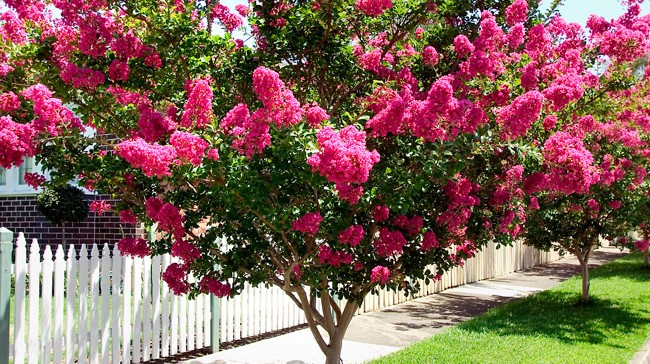Crepe myrtles are among the world’s best flowering trees.
They are native to eastern Asia and are hardy in most parts of Australia. Don looked at an exciting new range of crepe myrtle hybrids which reach different heights and spreads, and so reduce the need for pruning. They are also resistant to powdery mildew, a fungal disease that is difficult to control with fungicides.
Plant details
| Common name: | Crepe Myrtle |
| Botanic name: | Lagerstroemia indica |
Description: A deciduous, vase-shaped tree about 6-8m (18-25′) tall. It is often severely pruned and grown as a shrub 3-4m (10-12′) tall. Trusses of white, pink, mauve or purple blooms appear in late summer.
The petals are ruffled, with a crepe-like texture. In autumn the mid-green leaves turn yellow, orange or red (depending on the variety) before falling. Unpruned crepe myrtles develop beautifully coloured, smooth, mottled trunks. There is an Australian native crepe myrtle (Lagerstroemia archeriana), which grows to around 7m (20′) tall and has pinkish mauve flowers.
Indian Summer Crepe Myrtle (Lagerstroemia indica x L. fauriei)
The Indian Summer range has been specially bred to resist powdery mildew, a fungal disease that can be seen on some older crepe myrtle varieties. Each cultivar is named after an American Indian tribe, and they range in size from around 3-6m (10-18) fully grown.
Varieties shown were:
‘Acoma’ (white flowers and a weeping habit), 3m (10′)
‘Tonto’ (rich pink flowers), 3m (10′)
‘Zuni’ (mauve flowers), 3m (10′)
‘Sioux’ (carmine pink flowers) 4m (12′)
‘Yuma’ (pale pink flowers) 4m (12′)
‘Tuscarora’ (rose red flowers) 6m (18′)
‘Natchez’ (white flowers) 6m (18′)
Best climate:
Crepe myrtles grow well in most parts of Australia. In mountain zones plant in a warm, sheltered microclimate. The Indian Summer series have good cold tolerance.
Good points:
beautiful flowers autumn colour attractive bark many new varieties including ground cover varieties (sold as Chopin series)
Downside:
some older varieties are susceptible to powdery mildew prone to suckering
Pruning
Crepe myrtles can be heavily pruned in winter to encourage the development of long, arching branches of flowers. However, the downside of this annual pruning is that it creates an ugly, butchered looking plant. Left unpruned, crepe myrtles develop a naturally appealing shape and will flower well regardless. If a shrub is preferred, plant one of the new, smaller varieties, rather than pruning every year to keep a tree down to shrub size.
Care:
Keep well watered through summer. To reduce the risk of powdery mildew plant in an open, sunny garden situation with good air circulation. Alternatively select one of the mildew-resistant varieties. When plants are small remove spent flower heads in late autumn or winter to keep them tidy. Also remove low growth to develop a smooth, attractive trunk. To stop suckering problems avoid damaging the roots or lower trunk, mulch to prevent weeds or grass growing under the tree, and keep plants well watered in dry periods.
Getting started:
Crepe myrtles are available at nurseries. Plants in 200mm (8″) pots cost about $20, but larger plants in 300mm or 25 litre (12″) pots are priced at around $65.



